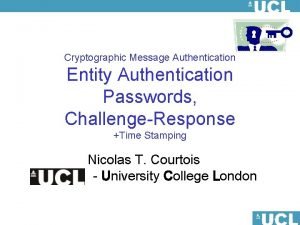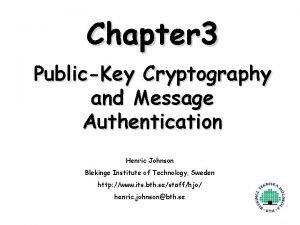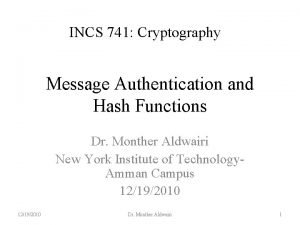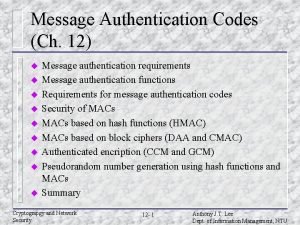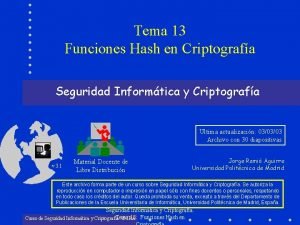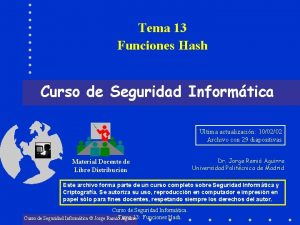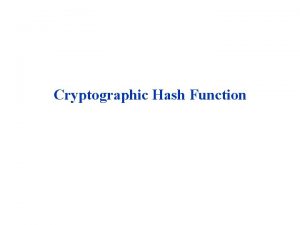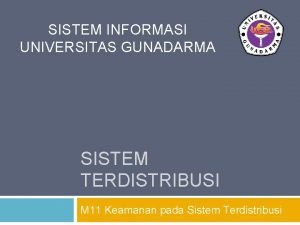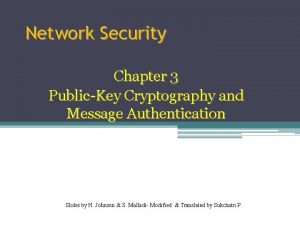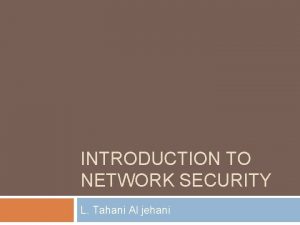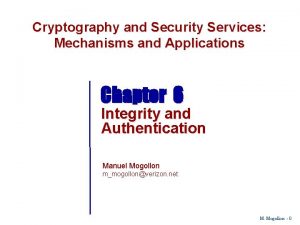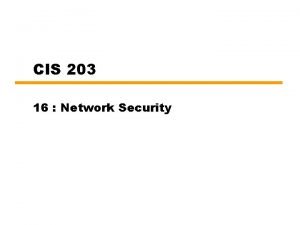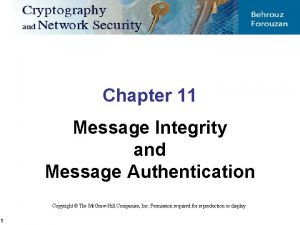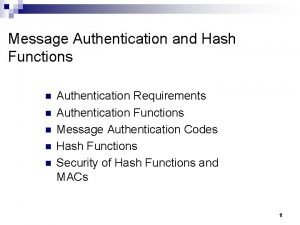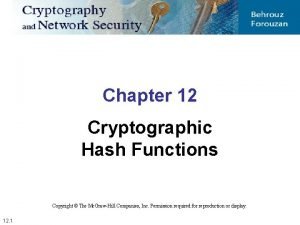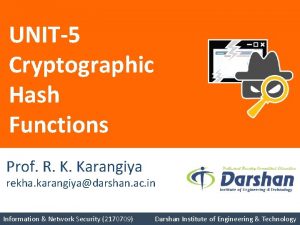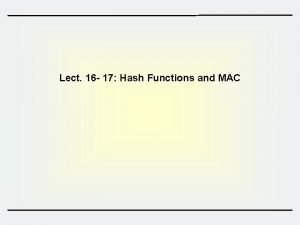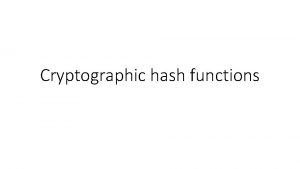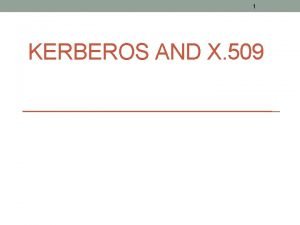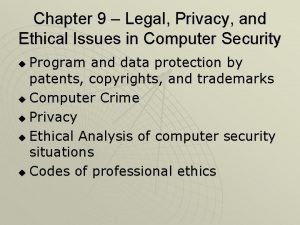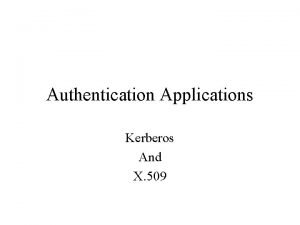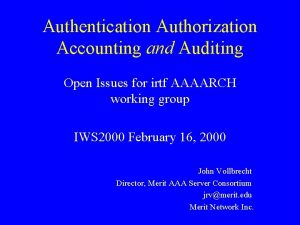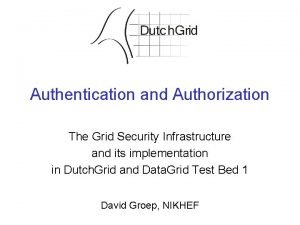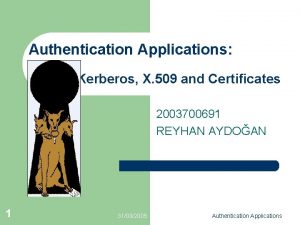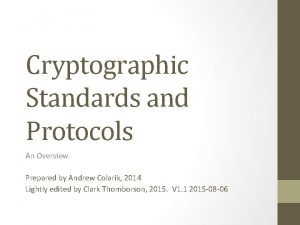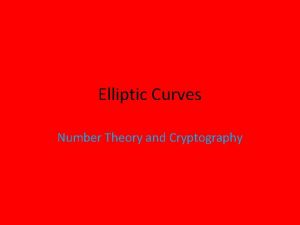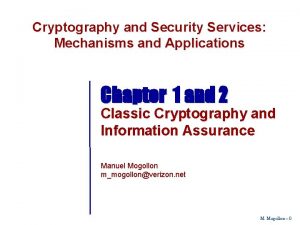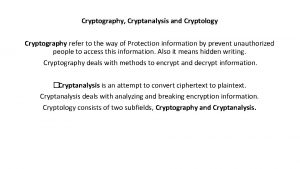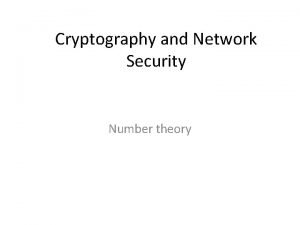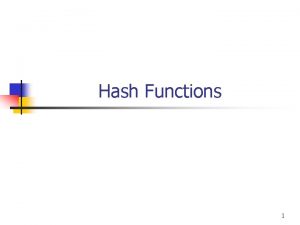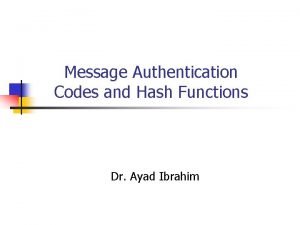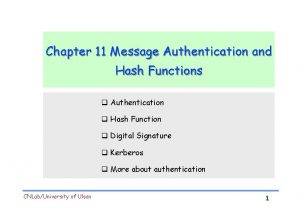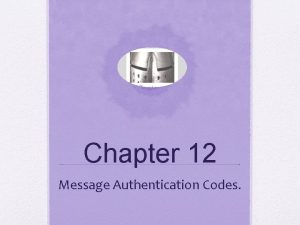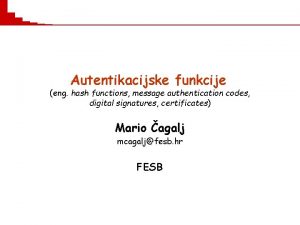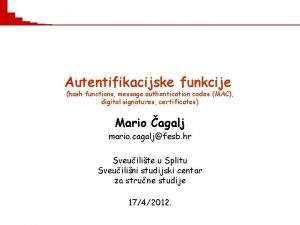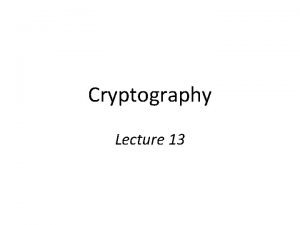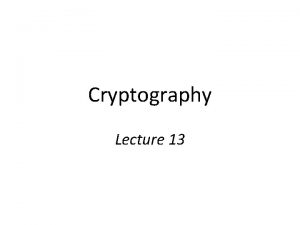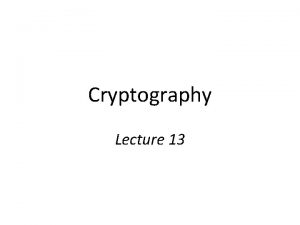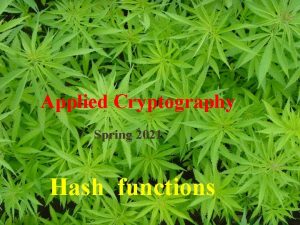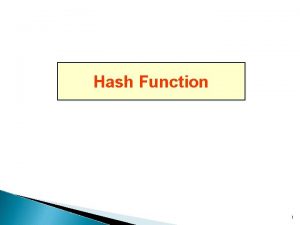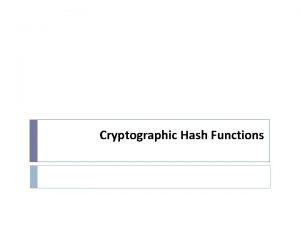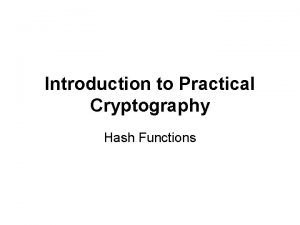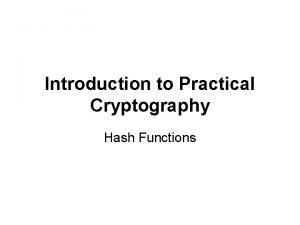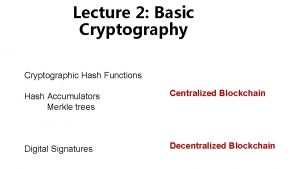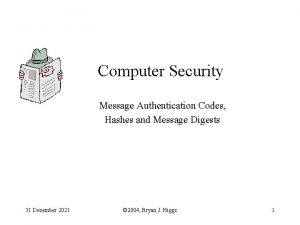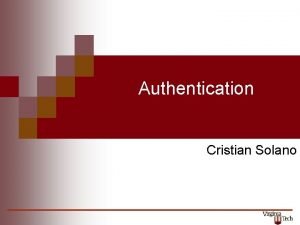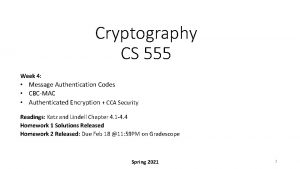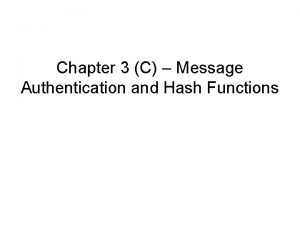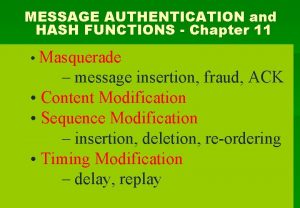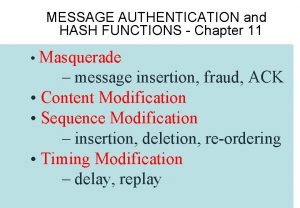Hash Functions and Message Authentication Codes Cryptography 1



















































- Slides: 51

Hash Functions and Message Authentication Codes Cryptography 1 September 12, 2013 Sebastiaan de Hoogh, TU/e

Announcements • Until this morning 50 students handed in 43 pieces of homeworks. (only 7 pairs) • BUT: Homeworks should be handed in by pairs!!! • I. E. : One solution sheet per two students. • AND: Homeworks should be mailed to crypto 13@tue. nl • Individual solutions will not be corrected from week 2 – This week all homeworks will be corrected though • There will be No Exceptions – Except for one student who is not in NL • Questions about homeworks: crypto 13@tue. nl September 12, 2013 1

how are hash functions used? • integrity protection – strong checksum – for file system integrity (Bit-torrent) or software downloads • one-way ‘encryption’ – for password protection • asymmetric digital signature • MAC – message authentication code – Efficient symmetric ‘digital signature’ • key derivation • pseudo-random number generation • … September 12, 2013 2

what is a hash function? • h : {0, 1}* {0, 1}n (general: h : S {0, 1}n for some set S) • input: bit string m of arbitrary length – length may be 0 – in practice a very large bound on the length is imposed, such as 264 (≈ 2. 1 million TB) – input often called the message • output: bit string h(m) of fixed length n – e. g. n = 128, 160, 224, 256, 384, 512 – compression – output often called hash value, message digest, fingerprint • h(m) is easy to compute from m • no secret information, no key September 12, 2013 3

hash collision • m 1, m 2 are a collision for h if h(m 1) = h(m 2) while m 1 ≠ m 2 I owe you € 100 I owe you € 5000 different documents • there exist a lot of collisions – pigeonhole principle (a. k. a. Schubladensatz) September 12, 2013 identical hash = collision 4

preimage • given h 0, then m is a preimage of h 0 if h(m) = h 0 X September 12, 2013 5

second preimage • given m 0, then m is a second preimage of m 0 if h(m) = h(m 0 ) while m ≠ m 0 ? X September 12, 2013 6

cryptographic hash function requirements • collision resistance: it should be computationally infeasible to find a collision m 1, m 2 for h – i. e. h(m 1) = h(m 2) • preimage resistance: given h 0 it should be computationally infeasible to find a preimage m for h 0 under h – i. e. h(m) = h 0 • second preimage resistance: given m 0 it should be computationally infeasible to find a second preimage m for m 0 under h – i. e. h(m) = h(m 0) September 12, 2013 7

other terminology • one-way = preimage + second preimage resistant – sometimes only preimage resistant • weak collision resistant = second preimage resistant • strong collison resistant = collision resistant • OWHF – one-way hash function – preimage and second preimage resistant • CRHF – collision resistant hash function – second preimage resistant and collision resistant September 12, 2013 8

relations between requirements • Theorem: If h is collision resistant then it is second preimage resistant – Proof: a second preimage is a collision. • Non-theorem: If h is second preimage resistant then it is preimage resistant – Non-proof: suppose that for any h 0 one can compute a preimage m. Then, given m 0, one can certainly do that for h 0 = h(m 0). – problem: to guarantee that m ≠ m 0 • in practice: collision resistant second preimage resistant September 12, 2013 9

pathologic counterexamples • if g : {0, 1}* {0, 1}n is collision resistant, then take h(m) = 1 || m if m has length n, h(m) = 0 || g(m) otherwise, then h is collision resistant but not preimage resistant • the identity function id : {0, 1}n is second preimage resistant but not preimage resistant September 12, 2013 10

hash function design - iterated compression September 12, 2013 11

Merkle-Damgård construction • assume that message m can be split up into blocks m 1, …, ms of equal block length r – most popular block length is r = 512 • • • compression function: CF : {0, 1}n x {0, 1}r {0, 1}n intermediate hash values (length n) as CF input and output message blocks as second input of CF start with fixed initial IHV 0 (a. k. a. IV = initialization vector) iterate CF : IHV 1 = CF(IHV 0, m 1), IHV 2 = CF(IHV 1, m 2), …, IHVs = CF(IHVs-1, ms), • take h(m) = IHVs as hash value • advantages: – this design makes streaming possible – hash function analysis becomes compression function analysis – analysis easier because domain of CF is finite September 12, 2013 12

padding • padding: add dummy bits to satisfy block length requirement • non-ambiguous padding: add one 1 -bit and as many 0 bits as necessary to fill the final block – when original message length is a multiple of the block length, apply padding anyway, adding an extra dummy block – any other non-ambiguous padding will work as well September 12, 2013 13

Merkle-Damgård strengthening • let padding leave final 64 bits open • encode in those 64 bits the original message length – that’s why messages of length ≥ 264 are not supported • reasons: – needed in the proof of the Merkle-Damgård theorem – prevents some attacks such as • trivial collisions for random IHV – now h(IHV 0, m 1||m 2) = h(IHV 1, m 2) • see next slide for more September 12, 2013 14

continued • fixpoint attack fixpoint: IHV, m such that CF(IHV, m) = IHV • long message attack September 12, 2013 15

compression function collisions • September 12, 2013 16

the MD 4 family of hash functions MD 4 (Rivest 1990) RIPEMD SHA-0 (RIPE 1992) (NIST 1993) RIPEMD-128 RIPEMD-160 RIPEMD-256 RIPEMD-320 (Dobbertin, Bosselaers, Preneel 1992) MD 5 HAVAL SHA-1 (Rivest 1992) (Zheng, Pieprzyk, Seberry 1993) (NIST 1995) SHA-224 SHA-256 SHA-384 SHA-512 (NIST 2004) September 12, 2013 17

design of MD 4 family compression functions message block split into words message expansion input words for each step IHV initial state each step updates state with an input word final state ‘added’ to IHV (feed-forward) September 12, 2013 18

design details • MD 4, MD 5, SHA-0, SHA-1 details: – – – 512 -bit message block split into 16 32 -bit words state consists of 4 (MD 4, MD 5) or 5 (SHA-0, SHA-1) 32 -bit words MD 4: 3 rounds of 16 steps each, so 48 steps, 48 input words MD 5: 4 rounds of 16 steps each, so 64 steps, 64 input words SHA-0, SHA-1: 4 rounds of 20 steps each, so 80 steps, 80 input words – message expansion and step operations use only very easy to implement operations: • bitwise Boolean operations • bit shifts and bit rotations • addition modulo 232 – proper mixing believed to be cryptographically strong September 12, 2013 19

message expansion • MD 4, MD 5 use roundwise permutation, for MD 5: – – W 0 = M 0, W 1 = M 1, …, W 15 = M 15, W 16 = M 1, W 17 = M 6, …, W 31 = M 12, (jump 5 mod 16) W 32 = M 5, W 33 = M 8, …, W 47 = M 2, (jump 3 mod 16) W 48 = M 0, W 49 = M 7, …, W 63 = M 9 (jump 7 mod 16) • SHA-0, SHA-1 use recursivity – W 0 = M 0, W 1 = M 1, …, W 15 = M 15, – SHA-0: Wi = Wi-3 XOR Wi-8 XOR Wi-14 XOR Wi-16 for i = 17, …, 80 – problem: kth bit influenced only by kth bits of preceding words, so not much diffusion – SHA-1: Wi = (Wi-3 XOR Wi-8 XOR Wi-14 XOR Wi-16 )<<<1 (additional rotation by 1 bit, this is the only difference between SHA-0 and SHA-1) September 12, 2013 20

Example: step operations in MD 5 • in each step only one state word is updated • the other state words are rotated by 1 • state update: A’ = B + ((A + fi(B, C, D) + Wi + Ki) <<< si ) Ki, si step dependent constants, + is addition mod 232, fi round dependend boolean functions: fi(x, y, z) = xy OR (¬x)z for i = 1, …, 16, fi(x, y, z) = xz OR y(¬z) for i = 17, …, 32, fi(x, y, z) = x XOR y XOR z for i = 33, …, 48, fi(x, y, z) = y XOR (y OR (¬z)) for i = 49, …, 64, these functions are nonlinear, balanced, and have an avalanche effect September 12, 2013 21

step operations in MD 5 September 12, 2013 22

trivial (brute force) attacks • assume: hash function behaves like random function • preimages and second preimages can be found by random guessing search – search space: ≈ n bits, ≈ 2 n hash function calls • collisions can be found by birthdaying – search space: ≈ ½n bits, ≈ 2½n hash function calls • this is a big difference – MD 5 is a 128 bit hash function – (second) preimage random search: ≈ 2128 ≈ 3 x 1038 MD 5 calls – collision birthday search: only ≈ 264 ≈ 2 x 1019 MD 5 calls September 12, 2013 23

birthday paradox • birthday paradox given a set of t (≥ 10) elements take a sample of size k (drawn with repetition) in order to get a probability ≥ ½ on a collision (i. e. an element drawn at least twice) k has to be > 1. 2 √t • consequence if F : A B is a surjective random function and #A >> #B then one can expect a collision after about √(#B) random function calls September 12, 2013 24

proof of birthday paradox • probability that all k elements are distinct is and this is < ½ when k(k-1) > (2 log 2)t (≈ k 2) (≈ 1. 4 t) September 12, 2013 25

meaningful birthdaying • random birthdaying – do exhaustive search on ½n bits – messages will be ‘random’ – messages will not be ‘meaningful’ • Yuval (1979) – start with two meaningful messages m 1, m 2 for which you want to find a collision – identify ½n independent positions where the messages can be changed at bitlevel without changing the meaning • e. g. tab space, space newline, etc. – do random search on those positions September 12, 2013 26

implementing birthdaying • naïve – store 2½n possible messages for m 1 and 2½n possible messages for m 2 and check all 2 n pairs • less naïve – store 2½n possible messages for m 1 and for each possible m 2 check whether its hash is in the list • smart: Pollard-ρ with Floyd’s cycle finding algorithm – computational complexity still O(2½n) – but only constant small storage required September 12, 2013 27

Pollard-ρ and Floyd cycle finding • Pollard-ρ – iterate the hash function: a 0, a 1 = h(a 0), a 2 = h(a 1), a 3 = h(a 2), … – this is ultimately periodic: • there are minimal t, p such that at+p = at • theory of random functions: both t, p are of size 2½n • Floyd’s cycle finding algorithm – Floyd: start with (a 1, a 2) and compute (a 2, a 4), (a 3, a 6), (a 4, a 8), …, (aq, a 2 q) until a 2 q = aq; this happens for some q < t + p September 12, 2013 28

security parameter • security parameter n: resistant against (brute force / random guessing) attack with search space of size 2 n – complexity of an n-bit exhaustive search – n-bit security level • nowadays 280 computations deemed impractical – security parameter 80 seen as sufficient in most cases • but 264 computations should be about possible – though a. f. a. i. k. nobody has done it yet – security parameter 64 now seen as insufficient in most cases • in the future: security parameter 128 will be required • for collision resistance hash length should be 2 n to reach security with parameter n September 12, 2013 29

provable hash functions • people don’t like that one can’t prove much about hash functions • reduction to established ‘hard problem’ such as factoring is seen as an advantage • Example: VSH – Very Smooth Hash – Contini-Lenstra-Steinfeld 2006 – collision resistance provable under assumption that a problem directly related to factoring is hard – but still far from ideal • bad performance compared to SHA-256 • all kinds of multiplicative relations between hash values exist September 12, 2013 30

SHA-3 competition • NIST started in 2007 an open competition for a new hash function to replace SHA-256 as standard • more than 50 candidates in 1 st round • Winner 2012: Keccak – Guido Bertoni, Joan Daemen, Michaël Peeters and Gilles Van Assche – “Family of Sponge Functions” September 12, 2013 31

Message Authentication Codes MACs September 12, 2013 32

Message Authentication Codes (MACs) • Efficient Signatures based on Symmetric Keys • Used to provide: – Integrity: • Messages cannot be modified by (active) interceptor – Data Origin Authenticity: • Some data originates from the entity it is claimed to come from • Should maintain confidentiality – Content of messages remains hidden from (passive) interceptor • Does not provide non-repudiation: – The originator of a message cannot deny this in front of a third party. By construction, sender and receiver would generate the same MAC on a certain message. • Example applications: IPsec and SSL September 12, 2013 33

(Weak) Constructions • September 12, 2013 34

Typical construction • September 12, 2013 35

Collisions for MD 5 September 12, 2013 36

Example Hash-then-Sign in Browser September 12, 2013 37

Wang’s attack on MD 5 • two-block collision – for any input IHV, identical for the two messages i. e. IHV 0 = IHV 0’, ΔIHV 0 = 0 – near-collision after first block: IHV 1 = CF(IHV 0, m 1), IHV 1’ = CF(IHV 0, m 1’), with ΔIHV 1 having only a few carefully chosen ± 1 s – full collision after second block: IHV 2 = CF(IHV 1, m 2), = CF(IHV 1’, m 2’), i. e. IHV 2 = IHV 2’, ΔIHV 2 = 0 • with IHV 0 the standard IV for MD 5, and a third block for padding and MD-strengthening, this gives a collision for the full MD 5 September 12, 2013 38

chosen-prefix collisions • latest development on MD 5 • Marc Stevens (TU/e MSc student) 2006 – paper by Marc Stevens, Arjen Lenstra and Benne de Weger, Euro. Crypt 2007 • Marc Stevens (CWI Ph. D student) 2009 – paper by Marc Stevens, Alex Sotirov, Jacob Appelbaum, David Molnar, Dag Arne Osvik, Arjen Lenstra and Benne de Weger, Crypto 2007 – rogue CA attack September 12, 2013 39

MD 5: identical IV attacks • all attacks following Wang’s method, up to recently • MD 5 collision attacks work for any starting IHV data before and after the collision can be chosen at will • but starting IHVs must be identical data before and after the collision must be identical • called random collision September 12, 2013 40

MD 5: different IV attacks • new attack – Marc Stevens, TU/e – Oct. 2006 • MD 5 collisions for any starting pair {IHV 1, IHV 2} data before the collision needs not to be identical data before the collision can still be chosen at will, for each of the two documents data after the collision still must be identical • • called chosen-prefix collision one example produced so far (2011) September 12, 2013 41

indeed that was not the end in 2008 the ethical hackers came by observation: commercial certification authorities still use MD 5 idea: proof of concept of realistic attack as wake up call à attack a real, commercial certification authority purchase a web certificate for a valid web domain but with a “little spy” built in prepare a rogue CA certificate with identical MD 5 hash the commercial CA’s signature also holds for the rogue CA certificate September 12, 2013 42

Outline of the Rogue. CA Attack September 12, 2013 43

Subject = CA Subject = End Entity September 12, 2013 44

problems to be solved predict the serial number predict the time interval of validity at the same time a few days before more complicated certificate structure “Subject Type” after the public key small space for the collision blocks is possible but much more computations needed not much time to do computations to keep probability of prediction success reasonable September 12, 2013 45

how difficult is predicting? time interval: CA uses automated certification procedure certificate issued exactly 6 seconds after click serial number : Nov 3 07: 44: 08 2008 GMT 643006 Nov 3 07: 45: 02 2008 GMT 643007 Nov 3 07: 46: 02 2008 GMT 643008 Nov 3 07: 47: 03 2008 GMT 643009 Nov 3 07: 48: 02 2008 GMT 643010 Nov 3 07: 49: 02 2008 GMT 643011 Nov 3 07: 50: 02 2008 GMT 643012 Nov 3 07: 51: 12 2008 GMT 643013 Nov 3 07: 51: 29 2008 GMT 643014 Nov 3 07: 52: 02 2008 GMT have a guess… September 12, 2013 46

the attack at work estimated: 800 -1000 certificates issued in a weekend procedure: 1. 2. 3. 4. 5. buy certificate on Friday, serial number S-1000 predict serial number S for time T Sunday evening make collision for serial number S and time T: 2 days time short before T buy additional certificates until S-1 buy certificate on time T-6 hope that nobody comes in between and steals our serial number S September 12, 2013 47

to let it work cluster of >200 Play. Station 3 game consoles (1 PS 3 = 40 PC’s) complexity: 250 memory: 30 GB collision in 1 day September 12, 2013 48

result success after 4 th attempt (4 th weekend) purchased a few hundred certificates (promotion action: 20 for one price) total cost: < US$ 1000 September 12, 2013 49

conclusion on collisions • at this moment, ‘meaningful’ hash collisions are – easy to make – but also easy to detect – still hard to abuse realistically • with chosen-prefix collisions we come close to realistic attacks • to do real harm, second pre-image attack needed – real harm is e. g. forging digital signatures – this is not possible yet, not even with MD 5 • More information: http: //www. win. tue. nl/hashclash/ September 12, 2013 50
 Message authentication and entity authentication
Message authentication and entity authentication Public key cryptography and message authentication
Public key cryptography and message authentication Authentication functions in cryptography
Authentication functions in cryptography Message authentication functions
Message authentication functions Tema de hash hash
Tema de hash hash Algoritmo abcde
Algoritmo abcde Peer entity authentication
Peer entity authentication Authentication in cryptography and network security
Authentication in cryptography and network security Two simple hash function
Two simple hash function Message signature hash
Message signature hash Message authentication code requirements
Message authentication code requirements Message authentication code
Message authentication code A digital signature needs a private key system
A digital signature needs a private key system Approaches to message authentication
Approaches to message authentication Message authentication is a service beyond
Message authentication is a service beyond Symmetric key
Symmetric key Ecb electronic signature
Ecb electronic signature Message authentication code
Message authentication code Message authentication code
Message authentication code Message integrity in cryptography
Message integrity in cryptography Message authentication requirements
Message authentication requirements Whirlpool cipher
Whirlpool cipher Hash functions
Hash functions üsha ü ü ü
üsha ü ü ü Hash functions
Hash functions Authentication applications kerberos and x.509
Authentication applications kerberos and x.509 Difference between law and ethic
Difference between law and ethic Authentication applications kerberos and x.509
Authentication applications kerberos and x.509 Authentication filters in mvc 5
Authentication filters in mvc 5 Authentication authorization accounting and auditing
Authentication authorization accounting and auditing Authentication and authorization infrastructure
Authentication and authorization infrastructure Kerberos x.509 authentication service
Kerberos x.509 authentication service How to solve evaluating functions
How to solve evaluating functions Evaluating functions and operations on functions
Evaluating functions and operations on functions Wireless security in cryptography and network security
Wireless security in cryptography and network security Modulo table
Modulo table криптографический модуль
криптографический модуль Number theory in network security
Number theory in network security Firewall in cryptography and network security
Firewall in cryptography and network security Cryptography standards and protocols
Cryptography standards and protocols Diffusion and confusion in cryptography
Diffusion and confusion in cryptography Divisibility and division algorithm in cryptography
Divisibility and division algorithm in cryptography Intruders in cryptography
Intruders in cryptography Elliptic curves number theory and cryptography
Elliptic curves number theory and cryptography Cryptography security services
Cryptography security services Primitive root
Primitive root Cryptography and network security 6th edition pdf
Cryptography and network security 6th edition pdf Pearson cryptography and network security
Pearson cryptography and network security Euler's theorem in cryptography and network security
Euler's theorem in cryptography and network security Cryptography and network security 4th edition
Cryptography and network security 4th edition What are cryptography and cryptanalysis
What are cryptography and cryptanalysis Euler's theorem in cryptography
Euler's theorem in cryptography
